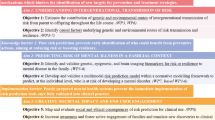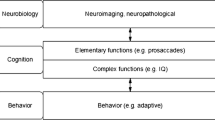Abstract
This study investigates the basic assumption of homogeneity of monozygotic (MZ) twins: are there differences according to the timing of the zygotic splitting, early in dichorionic (DC) and later in monochorionic (MC) pairs? We assessed the IQ of 451 same-sexed twin pairs of known zygosity and chorion type with the Wechsler Intelligence Scale for Children-Revised (WISC-R). The variances of within-pair differences were compared for monochorionic (MC), dichorionic monozygotic (DC-MZ) and dizygotic same-sexed (DZ) twins and structural equation modeling was applied. High heritability estimates were found for almost all subscales and IQ-scores. A significant effect of chorion type was found: the MC twins resembled each other more than the DC-MZ twins on the subscales Arithmetic and Vocabulary. The effect accounts for respectively 14% and 10% of the total variance.
Similar content being viewed by others
REFERENCES
Akaike, H. (1987). Factor analysis and AIC. Psychometrika 52: 317–332.
Baker, L. A., Asendorpf, J., Bishop, D., Boomsma, D. I., Bouchard, T. J., Jr., Brand, C. R., Fulker, D., Gardner, H., Kinsbourne, M., Lindenberger, U., Martin, N. G., and Mascie-Taylor, C. G. N. (1993). Group report: Intelligence and its inheritance-A diversity of views. In Bouchard, T. J., Jr. and Propping, P. (eds.), Twins as a tool of behavioral genetics, Wiley & Sons, Chichester, pp. 85–108.
Benirschke, K., and Kaufmann, P. (1995). Pathology of the Human Placenta, 3rd edn., Springer-Verlag,New York.
Boomsma, D. I. (1993). Current status and future prospects in twin studies of the development of cognitive abilities: infancy to old age. In Bouchard, T. J., Jr. and Propping, P. (eds.), Twins as a tool of behavioral genetics, Wiley & Sons, Chichester, pp. 67–82.
Brand, C. R. (1993). Cognitive abilities: current theoretical issues. In Bouchard, T. J., Jr. and Propping, P. (eds.), Twins as a tool of behavioral genetics, Wiley & Sons, Chichester, pp 17–32.
Brown, B. (1977). Placentation effects on birth weight and IQ in MZ twins. Paper presented at the meeting of the Society for Research in Child Development, New Orleans.
Cameron, A. H., Edwards, J. H., Derom, R., Thiery, M., and Boelaert, R. (1983). The value of twin surveys in the study of malformations. Eur.J.Obstet.Gynecol.Reprod.Biol. 14: 347–356.
Chitnis, S., Derom, C., Vlietinck, R., Derom, R., Monteiro, J., and Gregersen, P. K. (1999). X chromosome-inactivation patterns confirm the late timing of monoamniotic-MZ twinning. Am.J.Hum.Genet. 65: 570–571.
Christian, J. C., Kang, K. W., and Norton, J. A. (1974). Choice of an estimate of genetic variance from twin data. Am.J.Hum.Genet. 26: 154–161.
Derom, C., Vlietinck, R., Derom, R., Van den Berghe, H., and Thiery, M. (1988). Population-based study of sex proportion in monoamniotic twins. N.Engl.J.Med. 319: 119–120.
Derom, R. (1994). Fetal risks in multiple pregnancies. In Van Geijn, H. P., and Copray, F. J. A. (eds). A critical appraisal of fetal surveillance, Elsevier, Amsterdam, pp. 163–168.
Derom, R., Derom, C., and Vlietinck, R. (1995). Placentation. In Keith, L. G., Papiernik, E., Keith, D. M., and Luke, B. (eds). Multiple Pregnancy.Epidemiology, gestation and perinatal outcome, Parthenon, New York/London, pp. 113–128.
Derom, R., Vlietinck, R., Derom, C., Thiery, M., Van Maele, G., and Van Den Berghe, H. (1991). Perinatal mortality in the East Flanders Prospective Twin Survey (Preliminary results). Eur.J.Obstet.Gynecol.Reprod.Biol. 41: 25–26.
Devlin, B., Daniels, M., and Roeder, K. (1997). The heritability of IQ. Nature 388: 468–471.
Fulker, D. W., and Cardon, L. R. (1993). What can twin studies tell us about the structure and correlates of cognitive abilities? In Bouchard, T. J., Jr. and Propping, P. (eds.), Twins as a tool of behavioral genetics, Wiley & Sons, Chichester, pp. 33–52.
Godfrey, K. M. (1998). Maternal regulation of fetal development and health in adult life. Eur.J.Obstet.Gynecol.Reprod.Biol. 78: 141–150.
Gutknecht, L., Spitz, E., and Carlier, M. (1999). Long-term effect of placental type on anthropometrical and psychological traits among monozygotic twins: a follow up study. Twin Res. 2: 212–217.
Kaufman, A. S. (1975). Factor analysis of the WISC-R at 11 age levels between 6.5 and 16.5 years. J.Consult.Clin.Psychol. 43: 135–147.
Leroy, F. (1991) Embryology and placentation of twins. Encyclopedia of Human Biology, Vol. 3, Academic Press, Brussels, pp. 305–315.
Loos, R., Derom, C., Vlietinck, R., and Derom, R. (1998). The East Flanders Prospective Twin Survey (Belgium): a populationbased register. Twin Res. 1: 167–175.
Machin, G., Bamforth, F., Innes, M., and McNichol, K. (1995). Some perinatal characteristics of monozygotic twins who are dichorionic. Am.J.Med.Genet. 55: 71–76.
Melnick, M., Myrianthopoulos, N. C., and Christian, J. C. (1978). The effects of chorion type on variation in IQ in the NCPP Twin Population. Am.J.Hum.Genet. 36: 425–433.
Meulepas, E., Vlietinck, R. & Van den Berghe H. (1988) The probability of dizygosity of phenotypically concordant twins. Am.J.Hum.Genet. 43: 817–826.
Monteiro, J., Derom, C., Vlietinck, R., Kohn, N., Lesser, M., and Gregersen, P. (1998). Commitment to X-inactivation preceeds the twinning event in monochorionic-monozygotic (MC-MZ) twins. Am.J.Hum.Genet. 63: 339–346.
Nance, W. E. (1974). Note on the analysis of twin data (Letter to the editor). Am.J.Hum.Genet. 26: 297–299.
Neale, M. C. (1999). Mx: Statistical modeling, 2nd Edition, 150 pp.
Petrill, S. A., Saudino, K. J., Cherny, S. S., Emde, R. N., Hewitt, J. K., Fulker, D. W., and Plomin, R. (1997). Exploring the genetic etiology of low general cognitive ability from 14 to 36 months. Dev.Psychol. 33: 544–548.
Phillips, D. I. (1993). Twin studies in medical research: Can they tell us whether diseases are genetically determined? Lancet 341: 1008–1009.
Plomin, R., and Defries, J. C. (1998). Genetics of general cognitive ability and disabilities. Sci.Am. 278: 62–69.
Price, B. (1950). Primary biases in twin studies. A review of prenatal and natal difference-producing factors. Am.J.Hum.Genet. 2: 293–352.
Puck, J. M. (1998). The timing of twinning: more insights from X inactivation. Am.J.Hum.Genet. 63: 327–328.
Reed, T., Carmelli, D., and Rosenman, R. H. (1991). Effects of placentation on selected Type A behaviors in adult males in the National Heart, Lung, and Blood Institute (NHLBI) twin study. Behav.Genet. 21: 9–19.
Reed, T., Spitz, E., Vacher-Lavenu, M. C., and Carlier, M. (1997). Evaluation of a dermatoglyphic index to detect placental type variation in MZ twins. Am.J.Hum.Biol. 9: 609–615.
Rose, R. J., Uchida, I. A., and Christian, J. C. (1981). Placentation effects on cognitive resemblance of adult monozygotes. In Gedda, L., Parisi, P., and Nance, W. E. (eds.). Twin Research 3: Intelligence, Personality, and Development, Alan R. Liss, New York, pp. 35–41.
SAS Institute (1997). SAS release 6.12, Cary, NC.
Schatz, F. (1882–1910). Series of seminal articles listed in Strong and Corney (1967).
Sokol, D. K., Moore, C. A., Rose, R. J., Williams, C. J., Reed, T., and Christian, J. C. (1995). Intrapair differences in personality and cognitive ability among young monozygotic twins distinguished by chorion type. Behav.Genet. 25: 457–466.
Spitz, E., Carlier, M., Vacher-Lavenu, M.-C., Reed, T., Moutier, R., Busnel, M.-C., and Roubertoux, P. L. (1996). Long term effect of prenatal heterogeneity among monozygotes. Current Psychology of Cognition 15: 283–308.
Strong, S. J., and Corney, G. (1967). The placenta in twin pregnancy, Pergamon, Oxford.
Vlietinck, R. (1986). Determination of the zygosity of twins, Doctoral thesis, Katholieke Universiteit Leuven, Leuven.
Vlietinck, R., Derom, R., Neale, M. C., Maes, H., van Loon, H., Derom, C., Thiery, M. (1989). Genetic and environmental variation in the birth weight of twins. Behav.Genet. 19: 151–161.
Wechlser, D. (1986). Wechsler Intelligence Scale for Children-Revised (Dutch version), Swets & Zeitlinger B. V., Lisse.
Welch, P., Black, K. N., and Christian, J. C. (1978). Placental type and Bayley mental development scores in 18-month-old twins. In Nance, W. E. (ed.). Twin Research: Psychology and Methodology, Alan R. Liss, New York, pp. 145–149.
Williams, L. J., and Holahan, P. J. (1989). Parsimony-based fit indices for multiple-indicator models: do they work?. Structural equation modeling 1: 1661–1189.
Author information
Authors and Affiliations
Rights and permissions
About this article
Cite this article
Jacobs, N., Gestel, S.V., Derom, C. et al. Heritability Estimates of Intelligence in Twins: Effect of Chorion Type. Behav Genet 31, 209–217 (2001). https://doi.org/10.1023/A:1010257512183
Issue Date:
DOI: https://doi.org/10.1023/A:1010257512183




